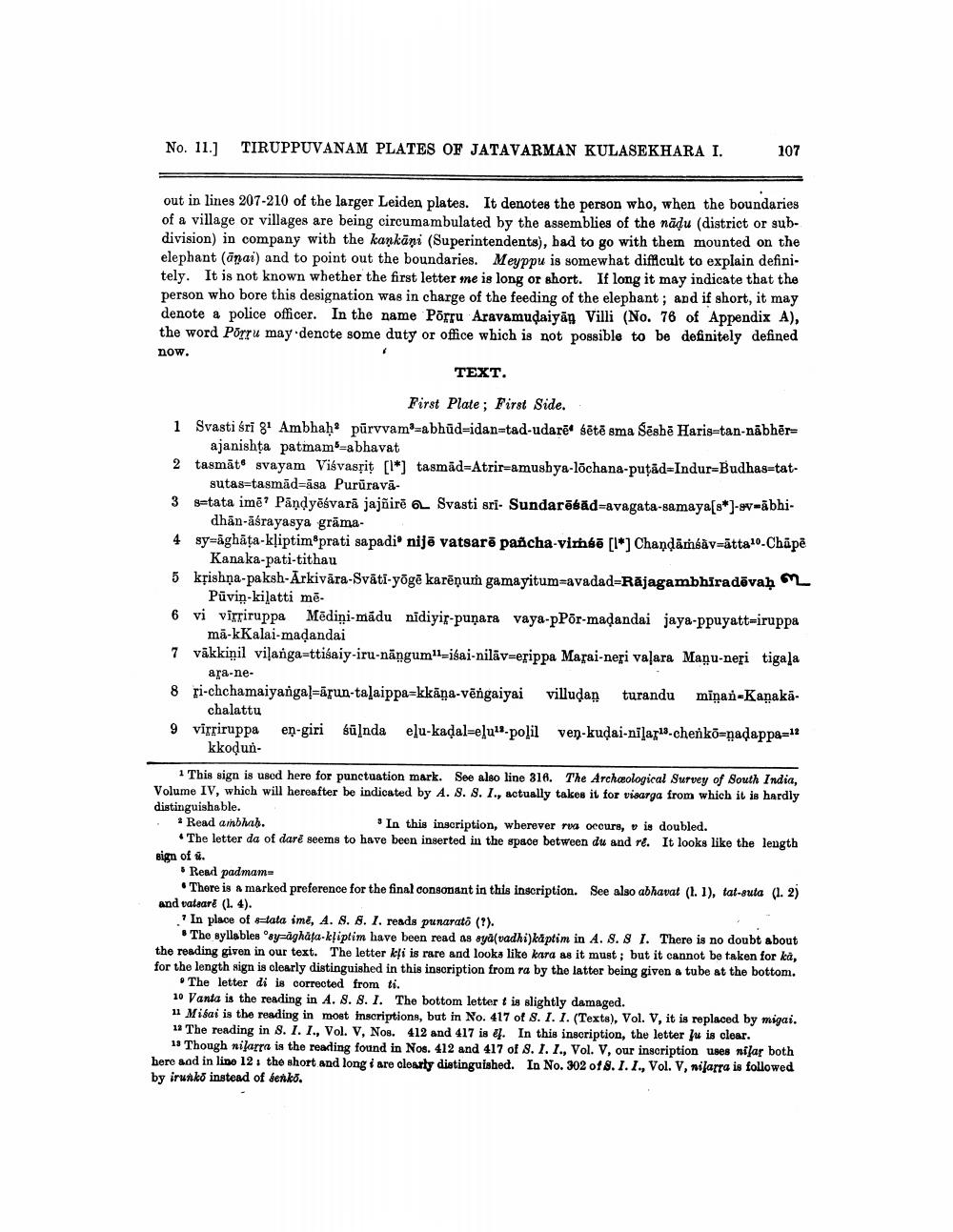________________
No. 11.]
TIRUPPUVANAM PLATES OF JATAVARMAN KULASEKHARA I.
107
out in lines 207-210 of the larger Leiden plates. It denotes the person who, when the boundaries of a village or villages are being circumambulated by the assemblies of the nadu (district or subdivision) in company with the kankani (Superintendents), had to go with them mounted on the elephant (anai) and to point out the boundaries. Meyppu is somewhat difficult to explain definitely. It is not known whether the first letter me is long or short. If long it may indicate that the person who bore this designation was in charge of the feeding of the elephant; and if short, it may denote a police officer. In the name Põrru Aravamuḍaiyan Villi (No. 76 of Appendix A), the word Porru may denote some duty or office which is not possible to be definitely defined
now.
3
TEXT.
First Plate; First Side.
1 Svasti śrī 81 Ambhaḥ purvvam-abhud-idan-tad-udarē sētē sma Seshe Haris-tan-nābher= ajanishța patmam-abhavat
2 tasmat svayam Viśvasrit [1] tasmād-Atrir-amushya-lochana-putad-Indur-Budhas-tatsutas-tasmad-asa Pururavā
s-tata ime' Pandyesvarā jajñire a Svasti sri- Sundarēsād-avagata-samaya[s*]-sv-abhidhan-asrayasya grāma
4 sy aghața-kliptim prati sapadi nije vatsarē pañcha-virée [*] Chanḍāméāv=atta10-Chapë Kanaka-pati-tithau
5 krishna-paksh-Arkivāra-Sväti-yōgē karēņum gamayitum avadad-Rājagambhiradēvaḥ Püvin-kilatti mē
6 vi vitrirappa Mediņi-mádu aldiyir-papara vaya-pPor-madandai jaya-ppuyatt-iruppa ma-kKalai-maḍandai
7 väkkinil vilanga-ttisaiy-iru-nangum"-isai-nilav-erippa Marai-neri valara Manu-neri tigala
ara-ne
8 ri-chchamaiyangal-gun-talaippa-kkina-vingalyai villudan turandu minan-Kanaka
chalattu
9 virriruppa en-giri sülnda elu-kaḍal-elu polil ven-kudai-nilar13-chenkō=ṇadappa=12 kkoḍun
1 This sign is used here for punctuation mark. See also line 316. The Archaeological Survey of South India, Volume IV, which will hereafter be indicated by A. 8. S. I., actually takes it for visarga from which it is hardly distinguishable.
* Read ambhab.
In this inscription, wherever rua occurs, is doubled. The letter da of dare seems to have been inserted in the space between du and re. It looks like the length sign of i.
Read padmam=
There is a marked preference for the final consonant in this inscription. See also abhavat (1. 1), tat-suta (1.2) and vatsare (1.4).
In place of stata ime, A. S. 8. I. reads punarato (?).
The syllables sy-aghata-kliptim have been read as sya(vadhi)kāptim in A. 8. 8 I. There is no doubt about the reading given in our text. The letter kli is rare and looks like kara as it must; but it cannot be taken for kā, for the length sign is clearly distinguished in this inscription from ra by the latter being given a tube at the bottom. The letter di is corrected from ti..
10 Vanta is the reading in A. S. 8. I. The bottom letter t is slightly damaged.
11 Misai is the reading in most inscriptions, but in No. 417 of S. I. I. (Texts), Vol. V, it is replaced by migai.
12 The reading in S. I. I., Vol. V, Nos. 412 and 417 is . In this inscription, the letter Ju is clear.
13 Though nilarra is the reading found in Nos. 412 and 417 of here and in line 12: the short and long i are clearly distinguished. by irunko instead of benko.
8. I. I., Vol. V, our inscription uses nilar both In No. 302 of 8. I. I., Vol. V, nilarra is followed




